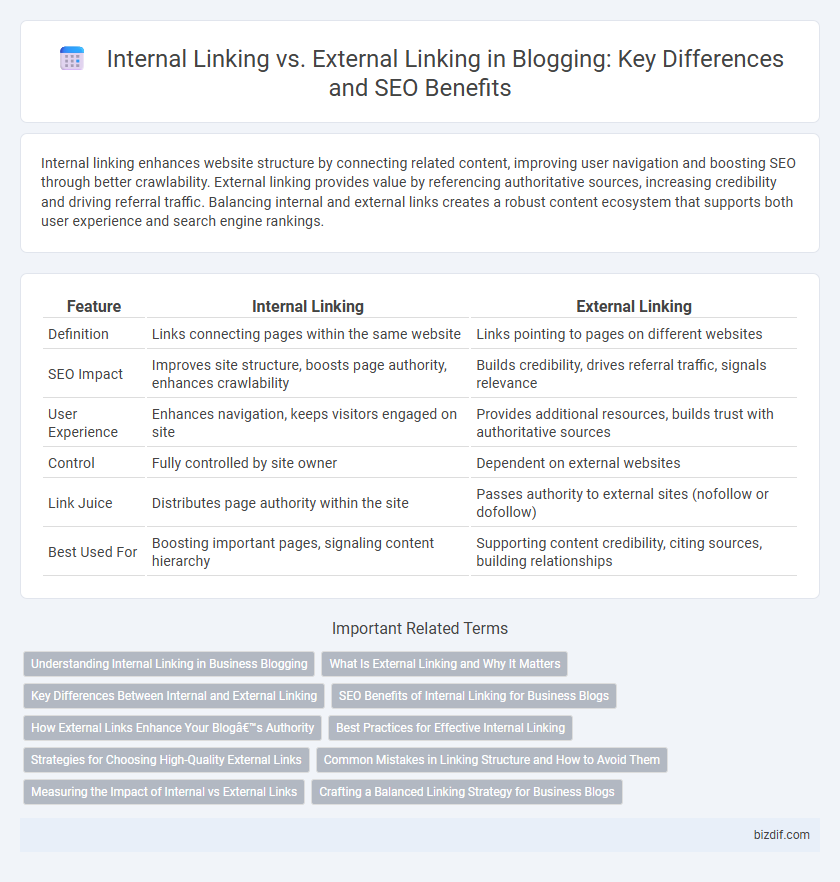Internal linking enhances website structure by connecting related content, improving user navigation and boosting SEO through better crawlability. External linking provides value by referencing authoritative sources, increasing credibility and driving referral traffic. Balancing internal and external links creates a robust content ecosystem that supports both user experience and search engine rankings.
Table of Comparison
| Feature | Internal Linking | External Linking |
|---|---|---|
| Definition | Links connecting pages within the same website | Links pointing to pages on different websites |
| SEO Impact | Improves site structure, boosts page authority, enhances crawlability | Builds credibility, drives referral traffic, signals relevance |
| User Experience | Enhances navigation, keeps visitors engaged on site | Provides additional resources, builds trust with authoritative sources |
| Control | Fully controlled by site owner | Dependent on external websites |
| Link Juice | Distributes page authority within the site | Passes authority to external sites (nofollow or dofollow) |
| Best Used For | Boosting important pages, signaling content hierarchy | Supporting content credibility, citing sources, building relationships |
Understanding Internal Linking in Business Blogging
Internal linking in business blogging enhances website navigation and distributes page authority, improving SEO performance and user experience. Strategic placement of internal links connects related content, increases time on site, and helps search engines index pages effectively. Optimizing anchor text with relevant keywords boosts keyword relevance and supports content hierarchy within the blog.
What Is External Linking and Why It Matters
External linking involves creating hyperlinks that point from your website to other authoritative sites, enhancing the credibility and relevance of your content. It plays a crucial role in improving search engine optimization (SEO) by signaling trustworthiness and providing readers with valuable resources. High-quality external links contribute to increased domain authority and can drive referral traffic, making them essential for a robust blogging strategy.
Key Differences Between Internal and External Linking
Internal linking connects pages within the same website, enhancing site navigation, distributing page authority, and improving SEO by guiding search engines through the site structure. External linking directs users to different domains, providing credibility, supporting content with authoritative sources, and potentially increasing referral traffic. The primary differences lie in their purposes: internal links focus on site cohesion and ranking distribution, while external links emphasize trustworthiness and relevance through third-party validation.
SEO Benefits of Internal Linking for Business Blogs
Internal linking enhances SEO by distributing page authority and improving site structure, allowing search engines to crawl and index business blog content more effectively. It increases user engagement by guiding visitors to related articles, which reduces bounce rates and boosts time-on-site metrics. Strategic internal links also help highlight priority pages, improving keyword relevancy and search rankings for targeted business topics.
How External Links Enhance Your Blog’s Authority
External links to reputable, high-authority websites signal trustworthiness to search engines, boosting your blog's credibility and ranking. Linking to well-established sources provides readers with valuable additional context, increasing engagement and dwell time. Strategic external linking supports SEO by associating your content with industry leaders and relevant resources.
Best Practices for Effective Internal Linking
Effective internal linking enhances website navigation by connecting relevant pages, improving user experience and boosting SEO performance. Prioritize linking to high-authority or cornerstone content using descriptive anchor text that naturally integrates target keywords. Regularly audit internal links to fix broken links and ensure a logical site structure that distributes page authority evenly across your blog.
Strategies for Choosing High-Quality External Links
Choosing high-quality external links involves selecting authoritative, relevant websites that enhance the credibility and value of your blog content. Prioritize linking to reputable sources with high domain authority and content that complements your topic, ensuring a positive impact on SEO and user experience. Avoid linking to low-quality or unrelated sites to maintain trustworthiness and improve your blog's search engine rankings.
Common Mistakes in Linking Structure and How to Avoid Them
Common mistakes in internal linking include overusing exact-match anchor text and creating orphan pages, which hinder site navigation and SEO performance. External linking errors often involve linking to low-quality or irrelevant sites, reducing your blog's authority and trustworthiness. To avoid these issues, maintain a balanced anchor text strategy, ensure every important page is linked internally, and vet external links for relevance and reliability.
Measuring the Impact of Internal vs External Links
Measuring the impact of internal versus external links involves analyzing metrics such as click-through rates, bounce rates, and conversion rates to determine which link type drives better user engagement and SEO benefits. Internal links enhance site structure and distribute page authority, improving crawlability and ranking for targeted keywords, while external links boost credibility and provide referral traffic from authoritative sources. Effective tracking through tools like Google Analytics and Search Console helps quantify link performance, guiding strategic link placement to maximize SEO outcomes and user experience.
Crafting a Balanced Linking Strategy for Business Blogs
Crafting a balanced linking strategy for business blogs involves integrating internal links to boost site navigation and promote relevant content while utilizing external links to establish credibility and connect with authoritative sources. Prioritizing a natural mix enhances SEO by distributing link equity effectively and improving user experience. Strategic placement of internal and external links supports content relevance, organic traffic growth, and increased domain authority.
Internal Linking vs External Linking Infographic

 bizdif.com
bizdif.com